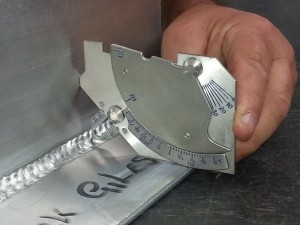Exploring the Importance of Welding Assessment in Industrial Applications: Safeguarding Against Failures and Enhancing Long Life
Welding assessment serves as a vital line of defense in commercial applications, making certain the architectural integrity and integrity of welded elements. By systematically recognizing flaws such as porosity and incomplete blend, evaluations not only prevent failings but additionally extend the life expectancy of crucial possessions.
Duty of Welding Evaluation
Welding inspection serves as a vital safeguard in industrial applications, ensuring that bonded frameworks meet defined standards of high quality and safety. This process includes a methodical exam of welds to verify their stability, toughness, and compliance with recognized codes and specs. The duty of welding assessment is complex, encompassing both visual analyses and non-destructive testing approaches, which may include ultrasonic, radiographic, or magnetic fragment screening.

Furthermore, welding inspection plays a crucial role in regulative conformity. Eventually, the role of welding examination is essential in advertising safety, improving performance, and securing financial investments in industrial facilities.
Usual Welding Defects

Among one of the most prevalent problems is porosity, characterized by small gas pockets trapped within the weld steel. This takes place because of impurities or inappropriate protecting gas, jeopardizing the weld's toughness. One more significant issue is incomplete fusion, where the weld steel stops working to bond effectively with the base material, potentially leading to architectural weaknesses.
Fractures can likewise develop throughout or after the welding procedure, often credited to thermal tensions or improper air conditioning prices. In addition, undercutting, where the base steel is worn down along the weld bead, can damage the joint and is typically caused by too much warm input or incorrect method.
Additionally, lack of infiltration occurs when the weld metal does not get to the origin of the joint, bring about insufficient toughness. Comprehending these usual defects is vital for welders and examiners alike to make sure that bonded structures meet security and efficiency requirements, inevitably protecting against prospective failures in commercial applications.
Benefits of Regular Evaluations
Routine examinations serve as an important safeguard in making certain the reliability and long life of bonded frameworks. These evaluations determine possible issues and weak points that might compromise the integrity of welds, allowing for prompt removal prior to concerns rise. By applying an organized evaluation regimen, companies can dramatically lower the threat of catastrophic failings that might cause expensive downtime, devices replacement, or perhaps accidents.
Additionally, routine evaluations contribute to enhanced quality control throughout the welding procedure. By sticking to a regular examination timetable, business can guarantee that their welding methods fulfill recognized quality benchmarks and ideal techniques. This not just promotes a culture of liability however likewise urges continual enhancement among welding employees.
Additionally, routine evaluations promote better maintenance preparation. By recognizing wear and tear early, organizations can tactically set up repair work and substitutes, reducing disturbance to procedures. site web This positive technique ultimately causes prolonged asset life-span and improved total performance.
Lastly, a dedication to routine evaluations can improve a firm's reputation in the industry. Clients and stakeholders increasingly worth companies that focus on safety and security and top quality, therefore boosting trust fund and possibly leading to increased business opportunities.
Sector Requirements and Rules
Following market requirements and policies is a fundamental aspect of welding inspection that enhances the advantages of normal examinations. These requirements, developed by companies such as the American Welding Society (AWS) and the American Culture of Mechanical Engineers (ASME), provide a structure for finest methods in welding processes, products, and assessment strategies. Conformity with these laws ensures that welds satisfy the needed quality and safety and security standards, dramatically reducing the danger of structural failings.
Regulatory bodies like the Occupational Safety and Wellness Administration (OSHA) further apply guidelines that protect workers and the environment throughout welding procedures. By following these developed standards, industries can enhance the integrity of their structures and parts, ensuring they do as intended under different functional conditions.
In addition, adherence to market criteria fosters consistency in top quality control, assisting in smoother interaction among stakeholders and governing agencies. This positioning not just minimizes liability dangers yet also improves the reliability of companies in open markets. Ultimately, compliance with welding criteria and laws is not merely a legal responsibility; it is a crucial investment in safety, performance, and long-lasting functional success.
Future Trends in Welding Examination
As sectors remain to evolve, the future of welding assessment is positioned to incorporate sophisticated modern technologies Check This Out that boost accuracy and effectiveness. One of one of the most considerable fads is the fostering of automation and robotics in examination processes. Automated systems can why not find out more conduct examinations swiftly, lowering human error and boosting throughput in making settings.
Moreover, the combination of expert system (AI) and device knowing formulas will certainly enable anticipating analytics, enabling real-time evaluations and positive maintenance (Welding Inspection Gilbert Arizona). By assessing information from previous assessments, these innovations can recognize patterns that might show prospective failures, thereby expanding the lifespan of welded components

Furthermore, the pattern in the direction of digitalization will certainly lead to enhanced information administration systems that promote better tracking, reporting, and compliance with market requirements. In recap, the future of welding inspection is defined by technical innovations that assure to significantly improve dependability, security, and functional performance in various industrial applications.
Conclusion
In verdict, welding examination offers an important feature in making certain the stability and sturdiness of welded frameworks across various commercial applications. As developments in modern technology continue to advance, the future of welding assessment promises increased accuracy and performance, eventually adding to the longevity of essential facilities.
Welding examination serves as a crucial line of protection in commercial applications, guaranteeing the architectural integrity and dependability of welded components.Welding inspection serves as an important protect in commercial applications, guaranteeing that welded structures meet defined criteria of high quality and safety and security - Welding Inspection Gilbert Arizona. Inevitably, the role of welding assessment is indispensable in promoting safety and security, enhancing performance, and shielding financial investments in industrial infrastructure
These requirements, developed by companies such as the American Welding Culture (AWS) and the American Culture of Mechanical Designers (ASME), provide a framework for best methods in welding processes, materials, and assessment strategies.In verdict, welding examination offers an essential feature in ensuring the integrity and resilience of welded structures across various commercial applications.